
Operation Chariot: 75th Anniversary
Author:
Lutz Pietschker
Version: 2017-05-28
Raid on St. Nazaire Bibliography
|
Raid on St. Nazaire Game
|
Home Page
|
Links
|
What's New
Saint-Nazaire Revisited
In 2002 I have been in Saint-Nazaire for the first time. In 2013 I attended the remembrance ceremony and took walks around the town and along the coast (you can read about them here and here). In 2017 I returned, this time for the 75th anniversary of the "Chariot" raid.
This page describes what I saw, with some remarks as to what has changed since 2002 and 2013. Note that this page is not made from the point of view of an historian, reporter or hiker but of a boardgame fan. Or something in between all of these; while writing it developed into a sort of rambling tale I am afraid.
Remark:
The images on this page are in reduced size. To see the original image, click the picture; the enlarged image will open in a new window.
The highlighted numbers in the text refer to the area numbers on the Raid on Saint-Nazaire game board (see the image hosted on BGG). It was this game that has started my interest in Saint-Nazaire. For more photos and historical information see the website of the Saint Nazaire Society and the Combined Ops website. There is also a companion article to this page, with some different pictures, in the boardgamegeek.com forum.
What was different?
I was: I have learned a bit of French in the years since my last visit; not enough to understand casual talk, but enough to express some of the things I want to say and to understand most written material. That made a big difference, but …
… it would have been even bigger if the French would not have learned as well: This time I met a lot more people who spoke English, many of them excellently. Time to trash one of the most common prejudices about the French. Merci beaucoup, mes amis !
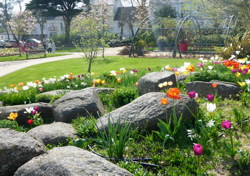 |
| The jardin des plantes in full bloom |
And: I was better prepared, had more time, and I knew the lay of the land. Also, I travelled with my wife, which shifted the perspective a bit and made the visit and the sights enjoyable in a different way.
On top of all that the weather was exceptional, it felt more like summer than early spring – last time (2013) it was cold and rainy much of the time (I actually put on gloves during a part of my "long hike" – ask my wife how unusual that is). This time, with day temperatures of up to 25° C, it really was like a summer vacation. Most of my wardrobe travelled back unused because the weather held throughout the next stops of our journey, i. e. Nantes and Paris (but these stops are outside the scope of this page).
And what else has changed?
The town itself is changing its outlook, and this had direct repercussions on two monuments related to Operation Chariot: Both the memorial and Campbeltown's gun have found new places in the port area; more on that later.
The reason behind that change of outlook seems to be the attempt to make Saint-Nazaire more attractive to tourists. That does not refer to the beaches along the coast, which belong to Saint-Nazaire in an administrative way, but one tries to offer tourists reasons to stay in the town itself. The town has lived well off its shipbuilding and aeronautic industries for a long time, but both of these industries come with a heavy risk: They need those rare, big orders to be able to keep the workshops running. The spectacular orders like that for Queen Mary II (in 2003) are few and far between, but "between" means that hundreds of highly specialized workers may go unemployed; it makes sense to put the town's economy on a broader basis, and tourism seems a good option for that.
However, while I was there STX Europe just completed the "most expensive cruise ship ever built", the MSC Meraviglia. When we arrived she was at the equipment quay, from the distance for all the world looking like a big hotel. She sailed for off-coast trials on March 30th, duly announced by the local press but too early for me – she used the high tide at 06:00. This first trial was less than two years after the first steel was cut, not a bad time to build such a monster. (Meanwhile, on June 1, 2017, MSC Meraviglia was delivered to her owners MSC Croisières.)
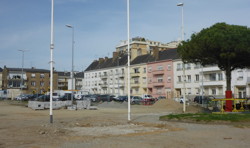 Back to the changes: One of the projects that was started with exceptional speed was the rearrangement of the beach area, namely the place du commando (408/409). This was the site of the Chariot memorial and of Campbeltown's gun and will shortly be a functional and nice end for the beach promenade that stretches westward all the way to Villes-Martin and continues from there as the chemin des douaniers (or chemin côtier) along the top of the cliff coast. There will be kiosks or pavilions that offer all the things a beach tourist would like to see ("facilities" are already in place) and which were not to be had in the vicinity, making the beach more attractive to tourists than it was before. I imagine that not everyone will be happy with that, up to now it seemed to be more or less the "private" beach of the citizens, not much frequented by tourists. I will give my opinion (tl;dr: positive) about the relocation of the monuments further down.
Back to the changes: One of the projects that was started with exceptional speed was the rearrangement of the beach area, namely the place du commando (408/409). This was the site of the Chariot memorial and of Campbeltown's gun and will shortly be a functional and nice end for the beach promenade that stretches westward all the way to Villes-Martin and continues from there as the chemin des douaniers (or chemin côtier) along the top of the cliff coast. There will be kiosks or pavilions that offer all the things a beach tourist would like to see ("facilities" are already in place) and which were not to be had in the vicinity, making the beach more attractive to tourists than it was before. I imagine that not everyone will be happy with that, up to now it seemed to be more or less the "private" beach of the citizens, not much frequented by tourists. I will give my opinion (tl;dr: positive) about the relocation of the monuments further down.
 The youth seem to have discovered the rocky sort-of-beach inside the avant port (406) to take the salt air (and what-not) in the evening, at least we saw some small and seemingly happy groups there. Above (between 405/409) is the new location of the anchor of the battleship Jean Bart; in 2013 it had a temporary place in front of the power station at the southern port entrance.
The youth seem to have discovered the rocky sort-of-beach inside the avant port (406) to take the salt air (and what-not) in the evening, at least we saw some small and seemingly happy groups there. Above (between 405/409) is the new location of the anchor of the battleship Jean Bart; in 2013 it had a temporary place in front of the power station at the southern port entrance.
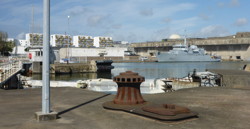 |
| Something is missing… the former site of le frigo, seen from the northernmost lock gate (343) of the "new" (southern) entrance. A detachment from the French minesweeper moored to the quai du commerce took part in the Chariot ceremony. |
One landmark of the Chariot raid has gone forever: Le frigo (434), the cold storage building that was erected in 1917 to supply the US troops, has been demolished in late 2016. The area south of the U-Boat pens (434/435/458/459/468), the current quai du commerce, is about to be redeveloped into a yacht harbour with the necessary accompanying facilities. The frigo building was the site of a couple of anti-aircraft guns in 1942; they dominated the complete harbour area and were a deadly danger to the boats and to the commandos throughout the raid.
Note the new buildings in the background along the boulevard de la Légion de l'Honneur. This is the style in which many of the new apartment buildings are done today. They look better, in particular less shabby, than many of the buildings quickly erected after 1945, but on the other hand they are much higher than the old ones and totally change the aspect of the town. I personally think that the smaller old buildings had a certain charme, but then I never had to live in one of them. I certainly must say that I have seen worse modern buildings than those visible in the picture.
The Breton Ceremony
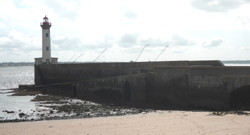 |
| The Old Mole at low tide |
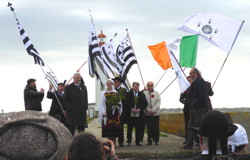 |
As usual, a Breton group has its own "Chariot" ceremony at 10:00, an hour before the official one. It certainly is a ceremony in remembrance for the raid and those who perished in it, but it also is a statement of Breton identity and independence, in thinking if not necessarily politically. Many of the local historians concerned with Operation Chariot also consider themselves Bretons or at least sympathize with Breton culture and history, and there is some tension between them and the local administration – the mayor does not look too kindly on the "extra" ceremony, and on the other hand the "Bretons" leave no chance unused to display some of their flags in the background of the official ceremony. To me it seemed that all this "conflict" is on a very low level, just pinpricks to assert one's presence and preferences, but I cannot honestly say that I understand the complete situation.
One complaint I heard from the "Breton historian" faction was that the local administration tries to keep all kind of war remembrance as low-key as possible. The authorities certainly prefer to look ahead and to present Saint-Nazaire not as a town in which the war has never ended but as a town on its way to a modern (and touristic) future, which is a difficult task seeing that the biggest landmark by far is a leftover of the war, namely the huge U-Boat bunker (300 m by 120 m by 18 m, to be precise), and there are many smaller concrete fortifications dotting the landscape. On the other hand some of the independent French (including Breton) historians have invested a lot of their time and money to collect historical evidence, in form of documents, interviews and artefacts, and saved it from being lost forever; it is natural that they expect some kind of official recognition, and hopefully even support, for their work. It is a pity that there is no better cooperation between these groups that basically should stand on the same side; I will remark some more on this in the "Grand Blockhaus" chapter. But as long as a Breton flag flies on top of the U-Boat bunker I prefer to think that this actually will turn out to be a passing animosity.
The Breton ceremony itself is both sober and short; it always takes place on the Old Mole, which means that in 2017 it was, for the first time, in the immediate vicinity to the official memorial area. Pipers play Breton tunes, men and women in historical costume are present, and short speeches are held – in French, not Breton, as far as I could hear, but my French was not up to the task to understand the details. After that a bouquet of gorse flowers (the national flower of Brittany) is given to the sea, and then the pipers lead the visitors off the mole. All through the ceremony flags of Brittany and of other Celtic nations and regions (like Ireland, Cornwall, Isle of Man) are on display.
Incidentally, I have seen that funeral parties also perform a ritual of giving gorsebush bouquets to the sea from the Old Mole. I stumbled into such a group in 2013 and, to my eternal shame, took some photos before realizing to what purpose they had assembled. I can only ask them for pardon, but the damage has been done.
The Operation Chariot 75th anniversary ceremony
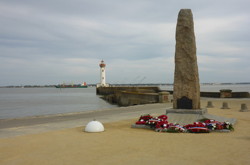 |
| The Old Mole and the Operation Chariot monument |
 |
| A detachment from the French minesweeper L'Aigle |
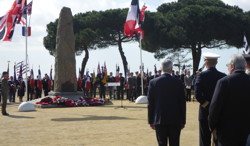 |
| The wreath-laying ceremony |
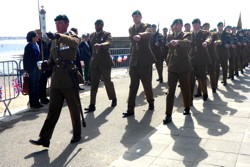 |
| A detachment of Commando Engineers leaves the site. |
Apart from the new location at the foot of the old mole, the ceremony was similar to the last time I was there. However, the area around the monument was cordoned off, and police guarded the vicinity – a consequence of the recent terror attacks in France. The inside of the cordon was reserved for officials, family members and members of veteran organisations. A team from BBC was covering the anniversary ceremony, which is also something I did not see before.
The official ceremony started at 11 h, as usual. I cannot give a complete guest list, but there was a presence of military and civilian officials from Great Britain and France, among them many members of the St.-Nazaire Society. The only veteran attending was Mr. Stephen Barney (HMS Atherstone); the other living veterans of the raid, Dr. Bill Watson and Major-General Corran Purdon, could not attend for personal reasons. Formations from a French Minesweeper and from British Commando Engineers attended the ceremony as well. A military attaché from the German embassy was present but held himself very much in the background, I guess protocol dictated that on an occasion like this; personally I would have liked to see him address the audience and express some sympathy with those who died 75 years ago. All in all it was a moving ceremony that reminded everyone that peace is not something that comes automatically, and that sometimes it can only be guaranteed or brought back by men and women determined to fight for it.
I could talk to Mr. Barney, though only shortly as he was in high demand. He seems to be quite popular in Saint-Nazaire (a local newspaper dedicated an article to him), and indeed he is a very lively and friendly character, it was a great pleasure to talk to him. Also, he speaks French fluently, in 2013 I saw him address, to great applause, the assembly at the mayor's vin d'honneur reception in the town hall.
Off the ceremony I also had the chance to talk again to James Dorrian, author of two great books about Operation Chariot. The exciting news: His plans to make a film about the raid seem to be making good progress. The producer will be a company called Port 20 Productions, and with the direct involvement of James Dorrian and also of Robert Lyman, author of the most recent English book on the raid, there is every hope that this may be the first full film that does the topic justice (though the BBC documentary was also excellent). Something to look forward to!
Finally a few links to articles in the local press:
The anniversary ceremony
Relocation of the Chariot monument
Relocation of Campbeltown's 12-pounder gun
Views of the port
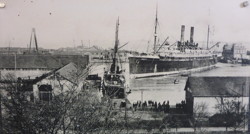 |
| The paquebot port in the 1920s (image from the open-air gallery on top of the U-Boat bunker) |
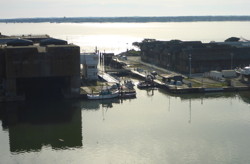 |
| The eastern (old) entrance lock |
 |
| A tourist boat fast outside the old (eastern) entrance (at 366). This boat looks slightly smaller than Ryder's MGB and MLs (both 34 metres long) |
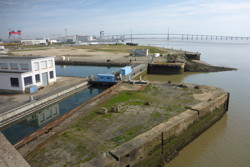 |
| The southern caisson of the Normandie dock (111) at low tide |
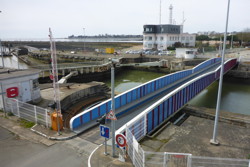 |
| The outer lock gates of the southern (new) entrance (313/321) |
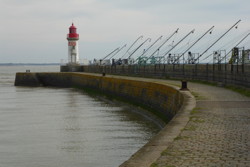 |
| Fishing nets on the western jetty of the avant port (from 412 towards 411) |
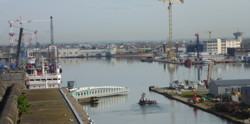 |
| The Penhoët basin with swing bridge 261 |
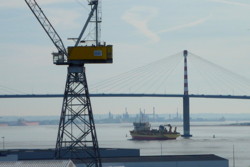 |
| The new chantiers navales (wharfs) and the Loire bridge |
Note: This is just a bit of rambling about one of my favourite landscapes, i. e. ports. It has not much to do with the "Operation Chariot" or "recent changes" topics. See this related page of mine if you want even more of this.
What a port this must have been! From a rocky promontory with a fishermen's village, then a station for the pilots who guided ships up to Nantes, Saint-Nazaire took its chance when ships became too large to go to Nantes: It developed into a port and a centre of shipbuilding itself, sending the docks of Nantes into a long and final decline. The construction (in mid-19th century) of the Saint-Nazaire basin as a non-tidal port, accessible only by the lock of the "old entrance", was a big step forward and allowed the port to develop very fast, later adding the Penhoët basin with its wharfs, then (in 1907) the "new" (southern) entrance to accommodate bigger ships. The construction of the forme Joubert (1932), also known as the Normandie dock, and the years after that were the grand days of transatlantic travel by ship, the time of the "packetboats", some remarkable specimens of which were built in the docks of this port.
Imagine the port at that time: cargo and passenger ships made fast to the quays of the Penhoët and Saint-Nazaire basins; cranes swinging bales into and out of ships' hulls; passengers arriving at the gare d'Orléans, just 100 metres away from the dockside and the ships waiting for them, having their baggage brought by hand-cart; the hooting of sirens and clanging of bells when ships manoeuvre in the basins; the locks busily working to receive more ships and to send others on their journeys … I would give a lot to have seen that myself.
I can recommend a few places to go to if you feel something similar: The Ecomusée (town history museum, at 362) with its models and displays, the Escal'Atlantic exhibition inside the U-Boat bunker for more impressions about the time of the packetboats (though I have yet to find out when this is open), the open-air image gallery on the roof of the U-Boat bunker, and the sightseeing platform on top of the sheltered lock next to the old entrance.
World war II war added an incredible amount of concrete to the port area and otherwise left it in a state of near-complete destruction, with the notable exception of exactly that concrete; the numerous air raids flattened the town but, irony of war, hardly even hit those structures, let alone damage them.
Saint-Nazaire took off from where it had been before the war and continued to build ships. The wharfs and docks outside the port area, already built at the beginning of the 20th century, were enlarged and by and by arrived at a size suitable for ships like Queen Mary II. Even the Normandie dock, repaired only after the war, resumed its role as a dry dock to fit out and repair big cruising ships, the closest you can get today to the days of the packetboat. Do take a walk around the Penhoët basin and into Penhoët itself if you want to see some more "portly views".
Penhoët also resumed its history of airplane construction when Airbus Industries chose it as one of their construction sites. Actual historical traces of the airplane (actually mostly seaplane) industry are scarce (except for some street names in Penhoët), but the Ecomusée gives a good account of this branch of industry as well.
If you like ports, do not miss the port of Saint-Nazaire!
Views of the town: Petit Maroc
 |
| The old town as it looked, more or less, at the time of the raid; view from the south, the foot of the old mole is just visible to the right. (Model in the Ecomusée) |
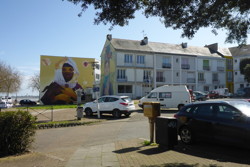 |
| 1950s houses at the place de la rampe (was: 327/333) |
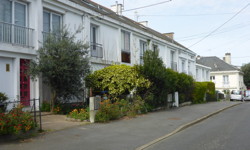 |
| Small houses in the rue de la vieille église |
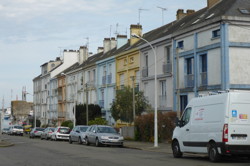 |
| The rue de l'écluse runs parallel to the southern entrance lock. |
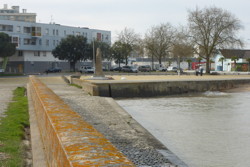 |
| View from the Old Mole (336) towards modern buildings |
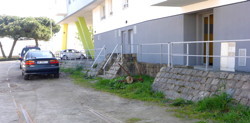 |
| Surprise: Old railway tracks and point lever in front of a new building (between 334 and 344) |
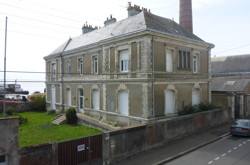 |
| The disused Santé Maritime (seaman's hospital, 316) |
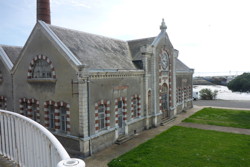 |
| (315) The old power station (usine électrique) and pump house (usine élévatoire) for the southern entrance; the avant port is visible beyond. |
 |
Avant-port: Power station, Santé Maritime (315/316) and workshops (306/307/308) seen from the eastern jetty (302) |
Yes, I know, petit Maroc (little Morocco) is a name that came from nowhere, seems to have no historical background whatever, and many Nazairiens think it should not be used. Properly speaking it is the "old town", the core from which the town of Saint-Nazaire developed. My only justification to having mentioned the name is that the official web pages of Saint-Nazaire use it, and that there used to be a café (closed by now) at the place de la rampe that was called "Petit Maroc". Adjacent you also find two murals (new since 2013) that play on the name.
At the time of Operation Chariot the old town was a maze of small streets and passages; a model in the Ecomusée shows what it must have looked like at that time, even if it represents an even earlier time with the old church (vieille église) still standing and the southern locks and the avant port way in the future. The only existing trace of that old town is a road through it, named rue de la vieille église. The church, by the way, was not a victim of the war but fell to redevelopment in 1896.
There are many traces of 1942 or, more generally, of World War II. Some are implicit, such as the absence of any old structures except the old mole, the seaman's hospital and the power station: The old town was razed by the Germans partly in reaction to the Chariot raid, allied bombing did the rest. Occupiers hate mazes in any case, and after the raid they were afraid that this particular jumble of passages and by-ways was the hiding place of a résistance movement. To assume that a strong underground movement had helped and supported the raid was an excuse that may have saved the necks of some German officers responsible for port security; had the severe post-raid investigation given evidence for more direct personal failure it could well have meant "maximal demotion" for them, to use Trevanian's expression (i. e. execution).
Like the rest of the town this quarter was, of necessity, re-built rather hastily with plain two- and three-story houses and apartment buildings and then, it seems, mainly forgotten. Among the "explicit" traces of the war are some concrete shelters (structures too difficult to pull down at the time, I assume) which were re-used as workshops and storage space.
Some cafés and bistros exist along the av. de vieille ville and have mostly survived, frequented by Nazairiens and the tourists who find their way there, maybe on their way to the Ecomusée or the old mole.
Only recently new, modern buildings have been added to the eastern corners of the quarter. Curiously, another pre-war trace is visible near the entrance of one of these (between 334 and 344): Railway tracks leading to the eastern jetty, and even a point lever, have been preserved. The arrangement makes it clear that this was done consciously, but there is no indication why. Charming.
The foot of the old mole is a natural point of interest (because you must pass it when going to its lighthouse-tipped head), and I like it that the Chariot memorial was moved to this spot (335). The place is not only well-visited, it was also one of the crucial locations during the raid, namely the place where the plans reaching beyond the destruction of the Normandie dock were shattered by a few Germans in gun positions and pillboxes; in my opinion, a fitting place to remember those who died. Today this is a quiet, open place that otherwise hosts a guide to Tintin's presence in the town and, in good weather, some pétanque players (a pastime that, shockingly, has been replaced by Mölkky for about half of Paris' youth – judging from one afternoon at the canal Saint Martin).
Following the rue de la vieille église south you have a good view at the Santé Maritime (316), the power station (315) and the Avant Port (in the game, area Z). The east jetty is now the mooring place for seagoing tugs, a reminder that this still is a port town and the "key to the Loire", as its coat of arms indicates. (Talking about blazonry, note the Breton "ermine" tincture in chief; it has been re-established there in 1990 after having previously vanished for reasons unknown.)
The area between the power station and the eastern jetty (306/307/308) is a heap of stuff with a maritime smell, corrugated-metal sheds and leftover bunkers. Someone must work there, but I have never seen a sign of life there on any of my visits.
I wish someone would find a new use (and the money to implement it) for this corner of the avant port. These are Sleeping Beauties that deserve to be kissed awake. There were talks about establishing arts projects there as long as I know the area. The reviving kiss, if it ever comes, will certainly not come for free; as of now it looks like nobody wants to pay for it. Please prove me wrong!
Other views of the town
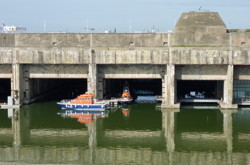 |
| View from across the Saint-Nazaire basin at the U-Boat pens, now a shelter for lifeboats |
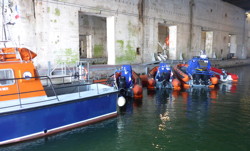 |
| More lifeboats inside the pen |
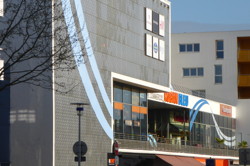 |
| The name of the Ruban Bleu shopping centre (blue riband) reminds us of the heyday of the packetboats |
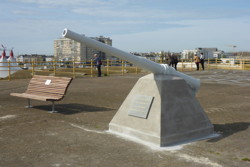 |
| Roof of the (post-Chariot) sheltered lock (201/202): The new home of Campbeltown's 12-pounder |
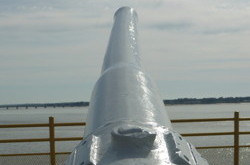 |
| The gun barrel bent by the explosion |
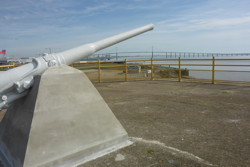 |
| View up-Loire towards the new docks and the Loire bridge |
 |
| The irregular patches on the port sheds form a pattern when viewed from a certain point. |
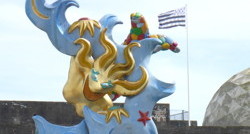 |
| Happy, if a bit frog-mouthed, mermaid on the esplanade des Antilles, in front of the U-Boat bunker and also of our hotel. Note the Breton flag I mentioned somewhere above. |
I used to tell everyone interested (or not) how impressed I was that the U-Boat pens were now used to harbour yachts. Well, no more. The southernmost pens are now used as practice rooms for what I take to be a louder kind of music, which seems to be an ideal use for them and proves that a shelter can work both ways. The next pens were now occupied with lifeboats, though maybe only for winter quarters as it seems impractical to keep a lifeboat inside the locks; actually there is a floating pier in the avant port that I saw used, in 2013, by the fire brigade. The rest of the pens is currently under reconstruction or houses the Escal'Atlantic (something like "Atlantic stopover") exposition that tells the story of Saint-Nazaire's involvement in the packet boat trade.
Another reminder of that time are the nearby shopping centres, the Ruban Bleu ("blue riband", close to the bunker) and the older Paquebot (town centre). I don't claim shopping as one of my hobbies and the finer distinctions may have escaped me, but shopping centres seem to become more and more similar all over Europe. But if you do not look at the shop windows you can find some nice details in some of them; in the passage through the Ruban Bleu it is the layout of the floor which continues the nautical theme and shows a large compass.
Coming back to the Operation Chariot theme, one site you should not miss is something that did not even exist in 1942: The sightseeing platform on top of the sheltered lock the Germans had built in 1943 (201/202). This gives the best view of the Saint-Nazaire basin, both entrances, the front of the U-Boat bunker and, of course, the southern end of the Normandie dock. Inside the shelter is a French submarine you can visit (L'Espadon, i. e. swordfish).
On top is the new home of Campbeltown's 12-pounder gun that was catapulted sky-high when the ship blew up in 1942; the gun was found by sheer chance in 1972 when dredging the harbour, some 100 metres away from the dock. The massive barrel was bent under its own inertia when accelerated by the blast, it is clearly visible with the naked eye. Again, I like the new location of this "monument", with its direct view at the primary objective of the raid: The last physical trace of HMS Campbeltown has come back to the place of the ship’s most influential action.
Next to the gun is a bench donated by "British sailors and army commandos of the St.-Nazaire-Society" and dedicated to the "brave Frenchmen and Frenchwomen who, risking life and liberty, rose to help us of their own free will". It invites to sit down, take the view and think about what has happened here; in our case it also helped some footsore tourists to recover.
This platform is also the only point from which you can see a quirky work of art: All over the port one notices red triangular patterns painted on silos, sheds and buildings in a seemingly random manner. From one point of the platform they all fall into place and form a pattern, a double row of triangles. A very nice and surprising effect, in my opinion.
Along the coast
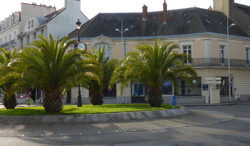 |
| The place des quattre z'horloges in bright sunshine |
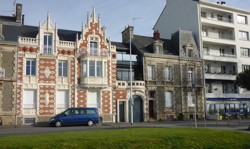 |
| The refurbished Hôtel Wilson on the boulevard Wilson, close to the beach promenade |
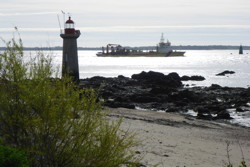 |
| Lighthouse of Villes-Martin |
 |
| Point de l'Eve |
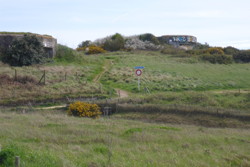 |
| The bunkers on the point de l'Eve |
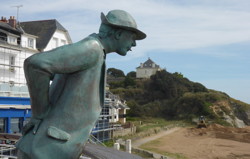 |
| M. Hulot looking out on "his" beach. |
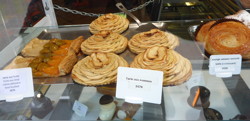 |
| French and Breton pastries |
In 2013 I walked to Escoublac and back, and this year I repeated the first and most beautiful third of the walk together with my wife: We walked to the beach of Monsieur Hulot at Saint-Marc sur mer. In 2013 I started at 6:00 h in barmy weather; this time it was much later, sunny, warm, flowers and gorsebush were in full bloom, an entirely different and very enjoyable experience.
The hôtel Wilson at the boulevard Wilson, hidden behind scaffolding in 2013, has been renovated and looks just splendid again. Otherwise the promenade and the cliff path were the same, including a detour for "necessary repairs" that seem to have developed into a permanent feature.
A little beyond, at the square du souvenir Français, there is a memorial monument that has a bit of a curious history: It was erected in 1910 in remembrance of the soldiers and seamen from Saint-Nazaire who died in the Franco-Prussian war of 1870. When the Germans arrived in World War II they promptly started to tear down monuments to recycle the metal; for example, the statue for the American soldiers fell victim to that iconoclasm. However, the memory of 1870 was a good one for the Germans, so they let this particular monument stand, either because they misunderstood it or because they decided to privately re-dedicate it to their own previous victory.
When the seaside promenade was modernized in 2010 this soldier changed his outlook: The statue was pivoted and now faces southward, towards the sea, instead of eastward towards the port.
A connection with the Chariot raid comes into view shortly before we arrived at Saint-Marc: The gun emplacements and bunkers at the pointe de l'Eve still stand (as do the remnants of a Napoleonic fort). Here were some of the guns that threatened the raiders on their way into the Loire estuary; had they fired, the history of the raid would have been a different one. I will mention the coastal artillery again in the "Grand Blockhaus" section, below.
Well, what shall I say – M. Hulot still stands on the beach pavilion. looking at "his" beach, but this time both the hôtel de la plage and the beach restaurants were open. We had a splendid meal at the hotel, later followed by coffee and some excellent (and splendidly colourful) pastries in a café in Saint-Nazaire, rue de la Republique (first café on the left when you come from the town hall – highly recommended).
Le Grand Blockhaus
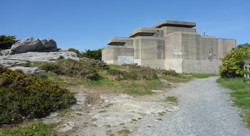 |
| View from the coastal path |
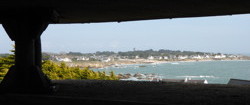 |
| View from the top level observation platform (eastward) |
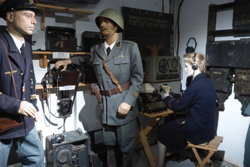 |
| Bunker scene in the exhibition |
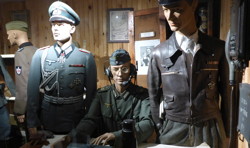 |
| Another scene in the exhibition – waiting for orders? |
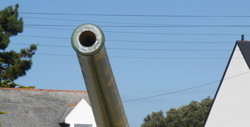 |
| 240 mm gun outside the Blockhaus |
Le Grand Blockhaus at Batz sur mer is a bunker turned museum; it usually opens on April 1st, and in 2013 I was quite sad that I could not see it. This time Thierry Guiheneuf arranged a special opening time for us, and we had the very good luck not just to see it but to get a guided tour by Luc Braeuer, one of the owners.
Yes, it is a privately owned bunker-cum-museum. It was founded by the brothers Luc and Marc Braeuer in 1997, and today they are actually owners of the site after the French admiralty finally decided that they no longer had any use for it. It is the first in their chain of 4 museums on local military history, concentrating on World War II. The Grand Blockhaus focuses on the German coastal defences (Atlantikwall) and in particular on the time of the poche (pocket), the state of siege Saint-Nazaire experienced from the autumn of 1944 to May 11, 1945, when it was finally liberated as the very last town in France, a full 3 days after Germany's official surrender.
In World War II the "Blockhaus" was an observation and fire control site (Feuerleitstelle) that directed the fire of several gun batteries along the Loire estuary, among them the 75 mm-guns at pointe de l'Eve. Batteries of very large calibre guns were in open emplacements some kilometres inland from the coast, such like the 240 mm guns the French built during the Great War and which they had to deliver to the occupiers. The smaller calibres (75 to 150 mm) were mostly in sheltered emplacements directly on the coast. A 240 mm gun and a German "8,8" gun are on display outside the Blockhaus.
In its function as a fire control position the Blockhaus has been one of the German departments responsible for the success of Operation Chariot.
From here they would have directed the guns that were supposed to prevent any intruder to enter the Loire (or, for that matter, to leave it again), but due to good British planning and a general confusion among German authorities they were not alerted until it was too late.
The exhibition in the Blockhaus is arranged on all 5 floors of the building, 3 of them being observation platforms. It relies a lot on exhibits given to Luc and Marc by the owners themselves, and it did not seem an exaggeration when Luc told us that he knew the story behind most of them. They are often arranged in lifelike displays, showing scenes that have (or could have) happened in the Blockhaus or similar sites. The exhibition actually shows very table on which the German fortress commander of Saint-Nazaire signed the surrender on May 11, 1945.
The tour of the exhibition, in particular with such a guide, was a very special experience. Thanks to Luc and Marc for opening a few days early, and to Thierry for arranging this!
Thierry not only arranged the Blockhaus tour, he was also friendly enough to drive us there and back, on the way giving us a tour of and explanations about the salt marshes of the Guerande region and even managing to infiltrate us, off hours, into the maison des paludiers at Saillé, a museum dedicated to the work and culture of the salt marshes.
Incidentally it also hosted an exhibition about Operation Chariot that had been put together by Thierry himself and at his own expense; he had offered this exhibition to the Saint-Nazaire authorities but they did not see fit to offer him any venue to display it. A sad decision, as the exhibition gave an excellent overview of the raid, its background and its impact on Saint-Nazaire. It is hard to see why it should not have been possible to make it accessible to many more people by hosting it, say, in the town hall or in the Ecomusée. As it was, only a few people ever heard of it, and even fewer had the chance to see it because Saillé is not easy to get to without a car.
Thierry, a big thank you! This day was a highlight of our visit to Saint-Nazaire, and I will not forget it.
And that's it for this time. Good-bye for now, Saint-Nazaire!

As the author of this page I take no expressed or implied responsibility for the content of external links; opinions expressed on such pages are not necessarily mine. The web space provider is not responsible for the contents of this page or any linked pages.


Written and published by Lutz Pietschker. Please send comments about technical problems to the
site master.
-Made with a Mac!-
, last change
2017-06-01















































